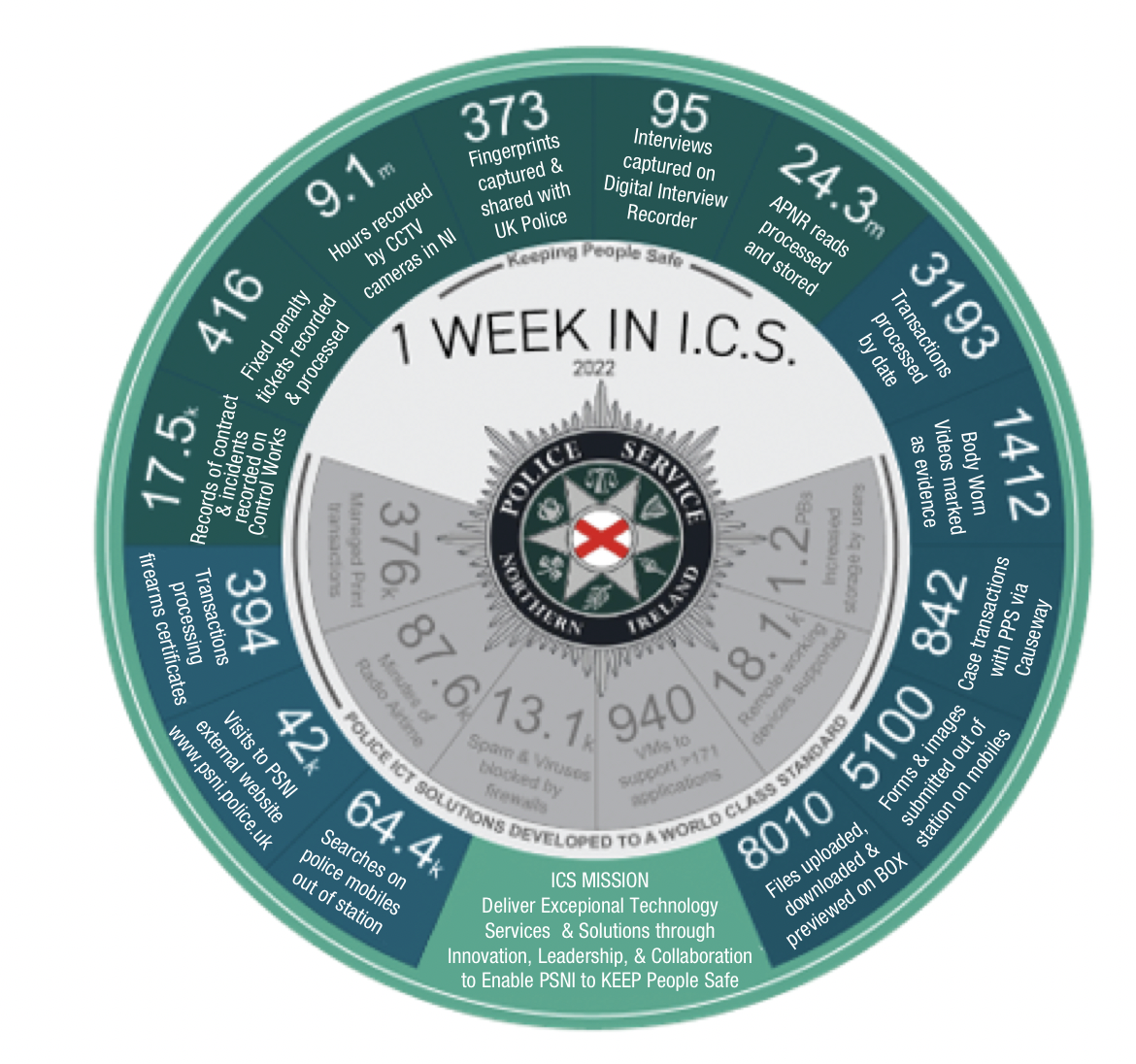Digital policing: Building a smarter force

PSNI Director of Information and Communications Service, Jeff McNamara, discusses the four strategic themes underpinning the digital modernisation of the PSNI.
Offering a context to the importance of delivering a smarter workforce, McNamara points to the Chief Constable’s recent announcement that the organisation faces a £40 million hole in its finances to March 2023.
The implications centre around recruitment, with the Director of Information and Communications Service estimating a drop of 300 officers by March 2023, compared to current levels. “Inevitably, that will affect our services,” he states. “It is my challenge to encourage better ways of working. To encourage the workforce, both officers and staff, about how we can work smarter to deliver the services we need.”
McNamara points to the PSNI’s Digital Strategy 2021 and Beyond as the primary vehicle for building a smarter force, tied in closely with the organisation’s modernisation plan Horizon 2025, and their in-year corporate business plan.
The PSNI’s digital strategy is built on four strategic themes of: digital investigation and evidence; digital engagement; digital collaboration; and mobility solutions.
Digital engagement
Highlighting digital engagement and evidence as a critical skill of the organisation, McNamara points to the launch of a new website in September 2022 as the platform on which the PSNI wants to build an engagement portal for members of the public.
“We recognise that we need to be able to provide a multi-channel offering for digital public contact. Whilst we currently offer the ability to report a crime through our website, interactions via social media are essentially a one-way message push.
“We are exploring the opportunities presented by the introduction of chatbots and social media integrations directly into our command-and-control system to better inform call handlers and dispatchers.”
McNamara explains that almost every incident today involves some form of digital evidence. Recognising this, the PSNI has launched a pilot for the public submission of evidence, with recognisable time and effort efficiencies for officers.
In 2023, the PSNI is planning to introduce the capability for members of the public to pay non-endorsable fixed penalty payments online.

Other future initiatives set out by the Director of Information and Communications Service is the introduction of citizen broadcasts and the ability for victims and witnesses to track updates on their case.
“A high percentage of calls to our 101 number are inquiries for updates on cases. We are aiming to push that information to victims and witnesses, providing a self-service function,” explains McNamara.
Digital investigation and evidence
Evidence is a major element of any police investigation and consequently, the PSNI has invested significantly in technology to both collect and provide evidence to partners.
On innovation in relation to digital investigation and evidence, McNamara points to the use of video analytics. “This new capability allows users to invoke various requests across a huge volume of video footage, for example to automatically detect the presence of a person in a video frame. This was successfully utilised during the Muckamore Hospital enquiry. It significantly reduced the time officers had to spend reviewing CCTV footage from within the hospital,” he explains.
Additional technology includes evidence gathering trucks (EGTs) and body-worn video. The latter of which, McNamara says, PSNI has around 4,500 currently deployed, with future capability expected to include sim-enabled cameras, providing live streaming capability and the option to review footage at the roadside.
McNamara also points to the state-of-the-art Cyber Crime Centre and remote evidence centres, which enables evidence to be given in court via remote connectivity from dedicated centres within the police estate.
Digital collaboration
On digital collaboration, McNamara says: “The PSNI collaborates with numerous other statutory bodies and agencies and a product of this collaboration has been our Geographic Information Portal. This tool is extremely beneficial for officer briefings and has multiple map layers providing a data-rich picture of events.
“One such layer produced through collaboration with An Garda Síochána and the Ministry of Defence is the ability to identify all border crossing points, which is hugely beneficial when engaged in cross-border operations.”
He adds: “PSNI has been sharing case files electronically with criminal justice partners for 15 years, however, the surge in digital evidence has resulted in the PSNI providing a cloud-based capability to transport this evidence to the PPS to assist in reaching their prosecutorial decision and onwards to courts for playback/display in court room.
“This has been live for over three years and has resulted in significant cost and efficiency savings through removal of the need to produce and transport DVDs to partners and defence solicitors.”
Mobility
Discussing mobility innovation, McNamara highlights the acceleration necessitated in response to the pandemic. March 2020 saw the PSNI pivot to a mobile workforce, with the rollout of 5,200 standard laptops to all business areas across PSNI, and an additional approximately 4,000 rugged Panasonic laptops issued to frontline Officers. With hybrid working now a request of most staff, the PSNI intends to have the future capability to dock laptops in various locations throughout their estate.
Origin, the PSNI’s next generation mobility solution, has an extensive capability currently, not least the ability to conduct national and local federated searches, intelligence submissions, and image management. However, as McNamara explains, future capability will include things like secure messaging (WhatsApp style), and Mobile ID giving officers the ability to check identity at the roadside by pairing with a portable fingerprint scanner which then checks against the national FP database Ident1.
McNamara concludes by offering an insight into a week of the PSNI’s Information and Communications Services Branch, highlighting the breadth and depth of technology delivered and supported through implementation of the Digital Strategy (Figure 1).





